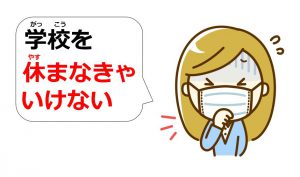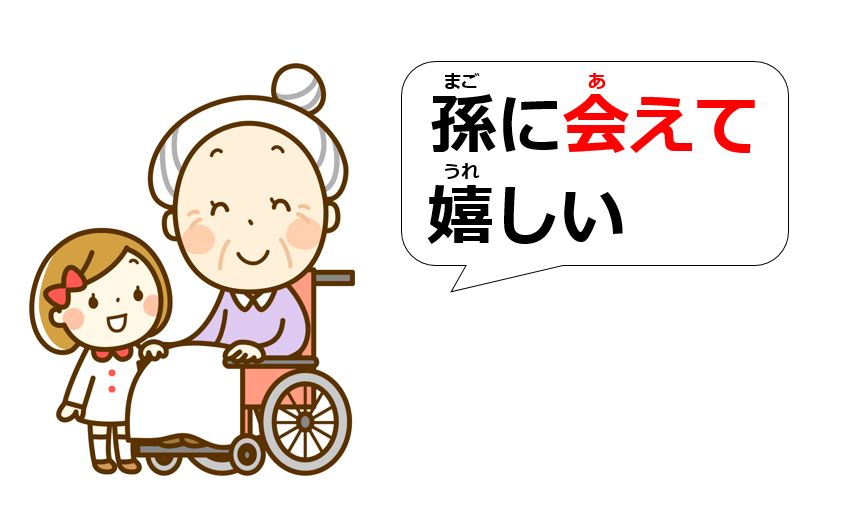You have entered a new section: Compound Sentences. In English, there are basically two ways to connect sentences. The first is to place conjunctions, e.g. “I will go to the park and my brother will go to the library.” The second is to utilize subordinate clauses, e.g. “I will watch a movie once my mother has gone to bed.” In Japanese, we express compound sentences by making conjugations. Thus, we will show you important sentence patterns one by one. In this lesson, you will learn how to express sequential and parallel actions.
Explanation for How to Express Sequential and Parallel Actions
| Table of Contents Sequential Actions or States The Te-form of Adjectives and Nouns Parallel Actions or States …たり…たりする: Parallel Markers for Verbs and Adjectives …し: Listing Multiple Reasons |
Sequential actions indicate that an action is accompanied with another, e.g. “the car suddenly made a loud sound and stopped.” With this example, we can say that the “stop” is the main event and “make a sound” is the sub-event. By contrast, parallel actions indicate that each action is independent and there is no difference in priority.
The Te-form: Expressing Both Sequential and Parallel Actions
Sequential Actions or States
| [私は] 魚を買って、 | 寿司を(作った / 作りました) |
| First Action | Second Action |
| [I] bought a fish and made Sushi. | |
The te-form allows you to combine two verbs or more and express sequence of actions or states. “、” is sometimes placed after the te-form if you find sentences are difficult to read, but the nuance won’t change. You can roughly consider the te-form in this context as “and” or “then.”
| 家に帰ってご飯を(食べる / 食べます)。 [I] will go home and eat a meal. |
| 部屋を掃除して、ゴミを(捨てた / 捨てました)。 [I] cleaned [my] room and disposed of the trash. |
Sequential actions or states can indicate reasons (causation) and means. In this context, please forget the translation “and” and “then,” and focus on the relation between the first part and the second part. The first part, expressed by the te-form, results in the second part.
| 手伝ってくれて、嬉しかった(です)。 [I] was happy that [you] helped [me]. |
| タクシーに乗って、駅まで(行った / 行きました)。 [I] went to the station by taking a taxi. |
The Te-form of Adjectives and Nouns
You can also conjugate adjectives and nouns into the te-form and combine them. Regarding the conjugation, you just add で after nouns and na-adjectives. With i-adjectives, you utilize the negative form and attach て instead of ない. Combinations between adjectives or nouns and verbs are applicable as the third example shows.
| 辛くて美味しいカレー(だ / です)。 [It] is a spicy and delicious curry. |
| 丈夫で重いドア(だ / です)。 [It] is a firm and heavy door. |
| 雨が強くて、外に出られ(ない / ません)。 The rain is strong, so [I] cannot go out. |
Parallel Actions or States
| 私は日本語を勉強して、 | 妹は英語を勉強(する / します) |
| Parallel Action | Parallel Action |
| I will study Japanese and my younger sister will study English. | |
The te-form can also express parallel actions or states. If there are two topics or subjects like the above example, we don’t usually omit them. This function is also applicable for nouns and adjectives.
| 今日はたくさん食べて(飲んだ / 飲みました)。 As for today, [I] ate and drank a lot. |
| 妹はかわいくて、頭がいい(です)。 My younger sister is pretty and smart. |
| 田中さんは女優で歌手(だ / です)。 Tanaka-san is an actress and a singer. |
Here is an exception. You can connect adjectives without using the te-form if two adjectives are different categories. That is to say, adjectives are categorized into three groups: the first is “Amount” and “Kind,” e.g. “多い: many” and “various: いろんな.” The second is “Subjective Judgments,” e.g. “好き: to like” and “いい: good.” The third is “Attributes,” e.g. “大きい: big” and “新しい: new.” When you use two adjectives from different groups, you can directly connect them.
| これが私の好きな甘いケーキ(だ / です)。 This is the sweet cake that I like. |
| いろんな古い車が(ある / あります)。 There are various old cars. |
Conjunctive Form (連用形)
| 家に帰り、ご飯を(食べる / 食べます) |
| タクシーに乗り、駅まで(行った / 行きました) |
| 私は日本語を勉強し、 妹は英語を勉強(する / します) |
| 辛く美味しいカレー(だ / です) |
| 雨が強く、外に出られ(ない / ません) |
In order to make your speech more formal, you can replace the te-form with a form called “Conjunctive Form” or “Continuative Form.” Depending on grammar guides, the terminology will change and thus please focus on the conjugation, which is fortunately very simple. This is applicable for only verbs and i-adjectives. You just drop ます from the polite form of verbs and ない from the negative form of i-adjectives.
| Polite Form (Verb) | Conjunctive Form | Negative Form (Adj) | Conjunctive Form |
|---|---|---|---|
| 見ます | 見 | 可愛くない | 可愛く |
| 食べます | 食べ | 寒くない | 寒く |
| 読みます | 読み | よくない | よく |
| 買います | 買い | 古くない | 古く |
| します | し | 強くない | 強く |
| 来ます | 来 | 辛くない | 辛く |
[adsense]
…たり…たりする: Parallel Markers for Verbs and Adjectives
| 赤ちゃんは | 急に | 泣いたり怒ったり(する / します) |
| Topic/Subject | Adverb | Verb |
| Babies suddenly get angry and cry (and do something else). | ||
This is the counterpart to the parallel marker や which is for nouns. The function is to list multiple actions or states, but imply that there remains something unlisted. The conjugation is to utilize the ta-form and attach り. One important point here is that the last verb or adjective has to be with する like たりする. This is applicable for adjectives and nouns with state-of-being, too.
| 本を読んだり、絵を書いたり(する / します)。 [I] read books and draw pictures (and do something else). |
| 温泉に行ったり、寿司を食べたり(した / しました)。 [I] went to the hot spring, and ate Sushi (and did something else). |
| お母さんは怖かったり、優しかったり(する / します)。 [My] mother is scary and tender (and something else). |
You can use たり with a single verb or adjective. This usage often appears when you want to imply something.
| タバコは病気の原因になったり(する / します)よ。 Lit. Tobacco becomes a cause of sickness (and something else). |
| 田中さんはよく宿題を忘れたりして(いる / います)。 Tanaka-san often forgets his homework (and does something else). |
You can express “He/She sometimes does X, but sometimes doesn’t” by using the plain and the negative form.
| 勉強は楽しかったり、楽しくなかったり(する / します)。 Studying is sometimes fun, but sometimes not fun. |
| 田中さんは学校に来たり、来なかったり(する / します)。 Tanaka-san sometimes comes, but sometimes doesn’t come to school. |
…し: Listing Multiple Reasons
| 田中さんは頭がいいし、 | 先生に向いて(いる / います) |
| Reason | Conclusion |
| Tanaka-san is smart (and something else), so he/she is suitable for a teacher. | |
The function is to list multiple reasons, but imply that there remains something unlisted. You can attach し to any parts of speech without conjugation, but nouns and na-adjectives need to be the state-of-being style, like 日本人だし and 元気だし. Just like り, you can also use this for a single reason while implying that there are other reasons.
| 疲れているし、眠いし、家に(帰ろう / 帰りましょう)。 [I] am tired, sleepy (and something else), so let’s go home. |
| 優しいし、丁寧だし、田中さんはいい人(だ / です)。 Tanaka-san is tender, polite (and something else), so he is a good person. |
| 雨が降ってきたし、カフェに(行かない / 行きませんか)? [It] has rained (and something else), so won’t [you] go to a café? |
Other Usage
…し also has a function to just list some items like the te-form and たり. The difference is that し indicates a nuance like “Not only A, but also B.” Take a look at the following comparison.
| お金もないし、時間もない。 [I] not only don’t have money, but [I] also don’t have time. |
| お金もなくて、時間もない。 [I] don’t have money or time. |
| お金もなかったり、時間もなかったりする。 [I] don’t have money, time (or something else). |
There are a few exceptions. The typical one is that し can express contrast with a particular word: かもしれない.
| 学校に行くかもしれないし、行かないかもしれない。 [I] may or may not go to school. |
Summary
- The te-form can express both sequential and parallel actions or states.
- The conjunctive form is interchangeable with the te-form, but sounds formal.
- たりする is a parallel marker for verbs and adjectives.
- …し can list multiple reasons.
The first lesson in the compound sentences section has been done. You might be surprised with the fact that Japanese can connect sentences with various nuances by not using conjunctions. Japanese certainly has conjunctions just like English does, however it is more common to use conjugations than conjunctions when connecting sentences. Thus, we will focus on that way here. Next, you will learn how to express negative sequential and parallel actions.

How to Express Prohibition and Obligation: だめだ, いけない, and ならない

Negative Sequential and Parallel Actions: …ないで, …なくて, and …ずに



